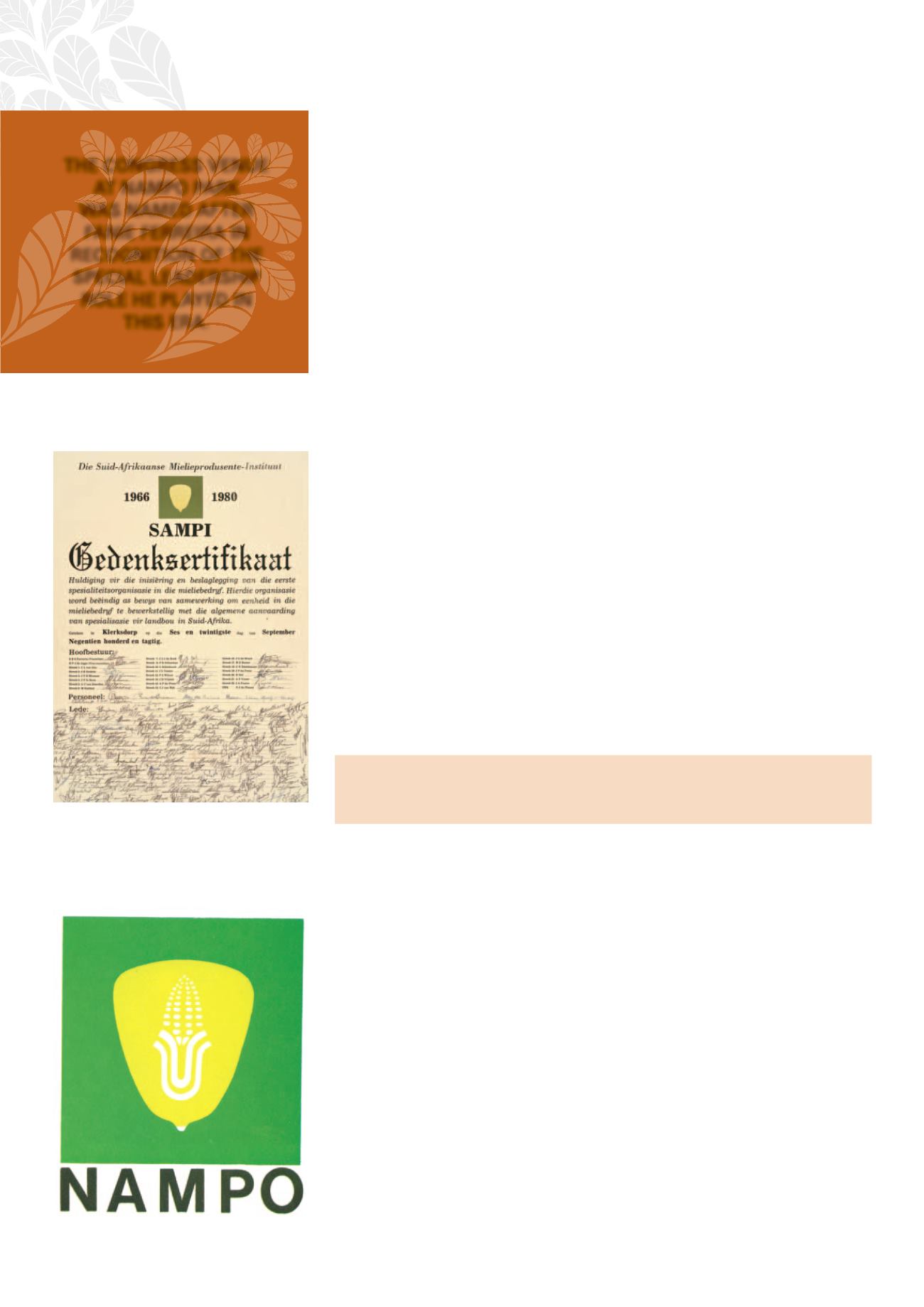

THE
GRAIN AND OILSEED INDUSTRY
OF SOUTH AFRICA – A JOURNEY THROUGH TIME
ႃႈ
At the founding Congress on 3 October 1980 the Congress decided that the new
organisation would function independently in terms of its own constitution, but
that it would affiliate with the SAAU.
Ferreira, the last Chairperson of SAMPI, was elected the first Chairperson of the
organisation, and De Jager, also from SAMPI, was the first Vice-chairperson.
When the Executive was appointed, nine members were elected from each of
the dissolved organisations.
The Congress also decided that the eight production members of the Maize Board
would be appointed by the Congress from its ranks, based on the regional division
used for the election of the Executive. With the exception of Von Abo, who had al-
ready gained a seat as producer representative on 1 January 1981, the designated
NAMPO members took their seats on the Maize Board on 1 July1981.
The decisions about the name of the organisation, the location of the head office and
the name of the magazine were left to the Executive, on condition that the name of the
organisation may not be SAMPI or SAMSO. The Executive consequently made the
following decisions on 11 November 1980:
• The name of the organisation: NAMPO
• Location of head office: Bothaville
• Magazine:
Mielies/Maize
At the founding Congress it was decided that the new organisation would provi-
sionally be known as the Maize Specialist Organisation (MSO). Thus NAMPO was
established, and the long-awaited ideal that maize producers could decide on their
own affairs in a specialist organisation was achieved.
THE NAMPO ERA BEGINS
Membership
Members of SAMPI and SAMSO did not have automatic membership of NAMPO
after the merger. Any producer who planted maize for commercial purposes could
apply for membership of NAMPO. The requirements for membership were that
the prospective member had to produce maize for marketing purposes, pay the
prescribed membership fees and support NAMPO’s objectives.
THE CONGRESS VENUE
AT NAMPO PARK
WAS NAMED AFTER
FANIE FERREIRA IN
RECOGNITION OF THE
SPECIAL LEADERSHIP
ROLE HE PLAYED IN
THIS ERA.
NAMPO’S MISSION
To broaden the economic living space of the maize producer.
SAMPI was terminated as proof of co-
operation to establish unity in the maize
industry. The Executive and members
signed a commemorative certificate on
26 September 1980.
At one stage it was a requirement for the applicant to produce more than a certain
quantity of maize to qualify to be a member of NAMPO. Later provision was made
to accept members on another basis than production, however, to make provision
for membership for emerging producers too. However, only the members who met
the production requirement were allowed to vote in the management structures
of NAMPO.
NAMPO did not permit affiliations from other interest groups. They argued
that NAMPO would not be able to achieve its specialisation objective if groups
with other interests from those of members were admitted, as different interest
groups naturally also had different objectives. NAMPO did pursue co-operation
with other role-players and interest groups in order to identify common prob-
lems and collaborate in this regard.
From the beginning it was one of NAMPO’s objectives to accomplish greater
co-operation between the different grain producer organisations. Since it was
founded, NAMPO pursued this objective actively from time to time by way of
mutual engagement between the industries, but without success.
Funding
Initially, apart from the revenue from the Harvest Day, NAMPO was funded only by
contributions from its members. In the period shortly after NAMPO was established,
















